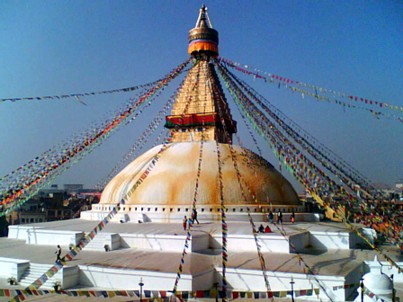Stupa

Stupa (Skt. stūpa; Tib. chöten; Wyl. mchod rten) — a reliquary monument symbolizing the enlightened mind of the buddhas. They can vary in size and shape, but often have a wide square base, a rounded middle and a tall conical section at the top. They are found in the great monasteries and Buddhist centres of countries such as India, Tibet, Burma, Sri Lanka and Thailand. Originally, stupas were built to enshrine the relics of the Buddha and his most important disciples. As symbolic representation of the enlightened mind of the Buddha, they are of great significance and importance.
The Eight Stupas
1. The Lotus Blossom Stupa of the Buddha's Birth
The Lotus Blossom Stupa symbolizes the birth of Siddhartha, the man who would later be known as the Buddha. He was born in the Lumbini Garden at Kapilavastu in Northern India, in the sixth century BCE.
2. The Enlightenment Stupa
After sitting in meditation for 49 days under a tree at Bodhgaya, Siddhartha attained enlightenment, and understood the true nature of all things. He realized that, like him, all beings without exception have the same potential for enlightenment, the ‘buddha nature’.
3. The Stupa of Turning the Wheel of Dharma
This stupa represents the point at which the Buddha began to 'turn the wheel of the Dharma', to teach the path to enlightenment to others.
In the Deer Park at Sarnath, near Benares, the Buddha met up with the five ascetics who earlier had been his meditation companions on the banks of the Nairanjara River. They became his first disciples and received his first teachings.
4. The Great Miracle Stupa
This stupa commemorates the Buddha’s display of miracles at Shravasti, where he was challenged to demonstrate his realization. The Buddha responded by performing a different miracle every day for 15 days.
5. The Stupa of the Descent from Tushita Heaven
The Buddha's mother, Mayadevi, was reborn in a celestial realm called the Tushita Heaven. To repay her kindness, the Buddha spent three months there and taught her the path to enlightenment.
This stupa represents the Buddha’s return from the celestial realms in order to continue teaching the people of northern India.
6. The Stupa of Reconciliation
This stupa symbolizes the Buddha’s reuniting of his monastic followers after they had become divided by disagreement.
7. The All-Victorious Stupa
This stupa symbolizes the Buddha’s agreement to extend his life by three months, after one of his followers had pleaded with him not to pass away.
8. The Parinirvana Stupa
This stupa marks the Buddha’s passing into nirvana, a state of true peace which is beyond death.
With his final words, the Buddha urged his followers to be diligent in their efforts to attain enlightenment. Lying on his right side and in a state of profound meditation, he left the world and passed into nirvana.
Further Reading
- Stupa: Sacred Symbol of Enlightenment, Crystal Mirror Vol. 12, Dharma Publishing, 1997. ISBN 0898002842